What Is Task Routing? How to Automate Workflows Smartly
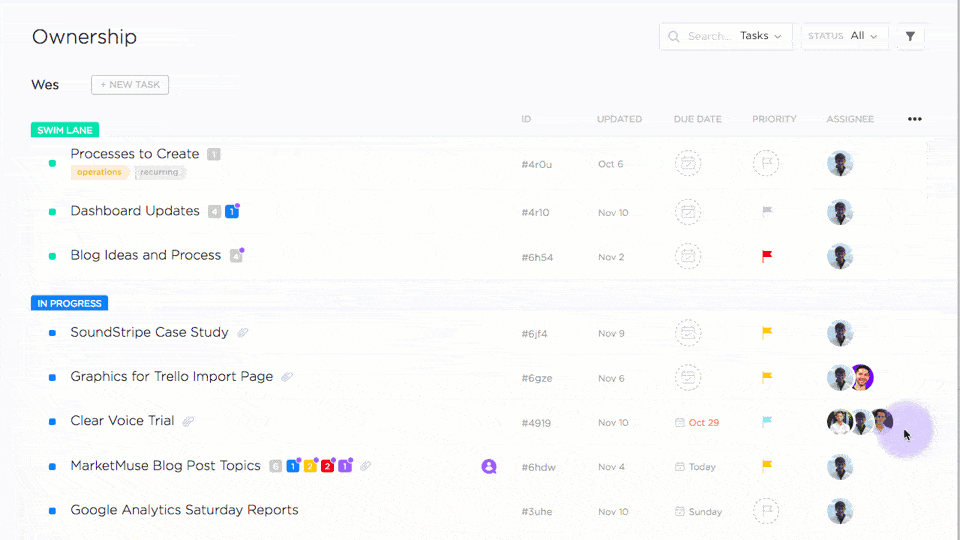
Sorry, there were no results found for “”
Sorry, there were no results found for “”
Sorry, there were no results found for “”

When managing a high-volume contact center or support team, assigning tasks based on availability alone is not enough.
What you need is smart task routing. It allows you to route tasks based on agent expertise, not just availability.
For example, routing tasks like billing queries to finance-trained reps. Or technical issues to product specialists.
For ops leaders and RevOps (revenue operations) teams, task routing means precision and excellence. You cut down on escalations, boost first-contact resolution, and give customers the right answers faster.
And for workflow-focused project managers, it means fewer fire drills and a more predictable, high-performing support engine.
By the end of this article, you’ll know how to implement task routing. Your team will be equipped to handle tasks at scale and reduce bottlenecks.
Task routing is the process of automatically assigning tasks, tickets, or requests to the most appropriate agent, team, or system based on predefined rules, logic, or real-time conditions.
Manually assigning tasks quickly becomes unsustainable in high-volume environments like customer support, IT operations, or RevOps. There are too many moving parts, too many requests, and too much at stake. That’s where task routing makes a difference.
Support teams work better when the system works for them—assigning tasks they’re best suited to handle, exactly when needed.
💡 Task routing involves criteria such as:
📮 ClickUp Insight: Nearly 88% of our survey respondents now rely on AI tools to simplify and accelerate personal tasks. Looking to generate those same benefits at work? ClickUp is here to help!
ClickUp Brain, ClickUp’s built-in AI assistant, can help you improve productivity by 30% with fewer meetings, quick AI-generated summaries, and automated tasks.
Now that we know what task routing is, let’s look at how it is implemented. Most systems rely on one or a mix of these three core models. Each has its own strengths and challenges.
Rules-based routing assigns tasks according to fixed, predefined logic, such as tags, form fields, or customer type. You set up the rules, and the system follows them.
For example, if a ticket includes the keyword “billing,” it gets routed to your finance-trained reps. A request marked “Urgent” or “VIP”? It’s pushed to your most experienced agents right away. It gives operations teams complete control over how tasks flow through the system.
Example: An e-commerce support team routes return-related queries to logistics specialists, cutting average handle time by 30%.
AI-driven routing assigns tasks dynamically by analyzing historical performance, ticket metadata, and contextual cues. It learns who handles what best, say, routing issues based on speed, skillset match, or past outcomes.
Unlike rigid rule-based systems, artificial intelligence adapts in real time and accounts for factors humans might overlook, like urgency or customer sentiment across customer support tools.
Example: An internal IT team uses AI to triage employee support tickets. Password resets go to junior agents, while infrastructure-related issues get routed to specialists.
🧠 Fun Fact: In 1950, Alan Turing posed the question, “Can machines think?” in his seminal paper, laying the groundwork for artificial intelligence and introducing the concept of the Turing Test.
Round-robin and load balancing models distribute tasks evenly across available agents in a strict rotation or based on each agent’s current workload. Instead of skill or topic matching, this flexible approach focuses on fairness and speed.
If one agent has five open tickets and another has two, the next task goes to the latter. It works well when you need volume cleared without overloading one team member.
Example: A B2C e-commerce support team uses load balancing to auto-assign tickets across 20 agents during the sales season. This ensures no one rep gets overwhelmed while maintaining the same-day response SLAs.
Here’s a side-by-side comparison of the three task routing approaches.
| Routing type | Key differentiator | Common challenge |
| Rule-based routing | Total control and transparency | Becomes rigid or outdated as processes evolve |
| AI or machine learning | Adapts and improves over time based on real-world patterns | Requires clean data and frequent tuning |
| Round Robin/load balancing models | Fairness and speed over specialization | Ignores complexity or urgency |
Smart task routing solves several everyday headaches for support and ops teams. Here’s what you stand to gain.
📚 Read More: Workflow Automation Examples
Think task routing is just for support tickets? Think again. Here are real-world use cases across departments, from sales leads to bug reports.
As a support lead, you have a critical goal. Resolve issues fast without burning out your team. But with hundreds of tickets coming in daily, ranging from “login failed” to “refund request,” manual triaging becomes a bottleneck.
Your agents might be spending too much time picking tickets or handling issues they’re not best equipped for. That leads to slower responses, more escalations, and poor CSAT scores.
Using task routing, you can assign each ticket based on expertise, priority, or client tier. Technical bugs go to product-trained reps and VIPs go to your most experienced agents.
Workflow focus: Routing by issue type + customer tier
Visual: Decision tree

Your sales teams thrive on speed and precision. Task routing automatically assigns inbound leads based on territory, industry, deal value, or rep availability.
Instead of wasting time figuring out who owns what, routing logic ensures the right sales rep follows up fast.
AI models can prioritize leads by fit or intent score, helping your reps act on high-value prospects first. This translates to faster deal cycles and less lead leakage.
If you’re an SDR manager, routing keeps your pipeline organized and performance predictable.
Workflow focus: Routing by lead metadata and fit score
Visual: Linear flow with filters
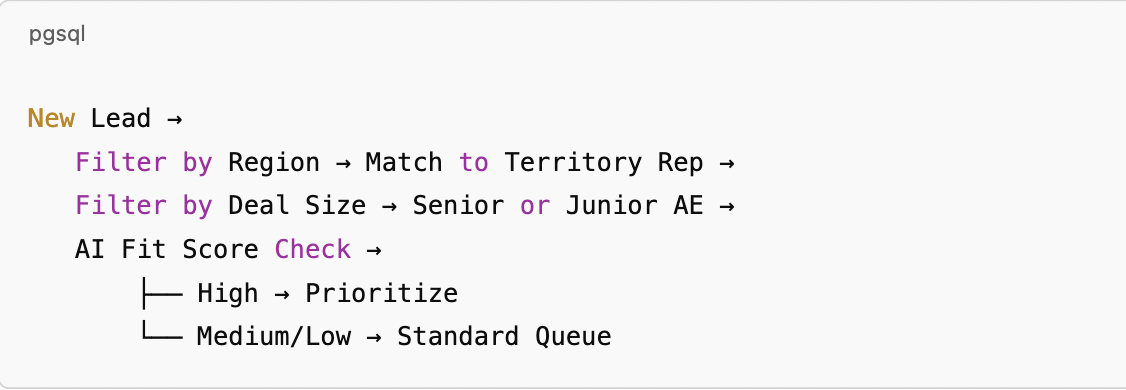
⚡ Template Archive: Sales Funnel Templates to Generate More Leads
Let’s say you’re an IT operations manager supporting 250+ enterprise clients. At any given time in a day, you’re flooded with internal and customer-facing requests.
These tickets often land in shared inboxes or generic queues, making prioritization chaotic. Your team spends more time figuring out where each task belongs than resolving them.
With task routing, you can set the rules to automatically classify and route each request based on issue type or urgency.
Software access requests go to identity management, device issues go to desktop support, and P1 client escalations are flagged and routed directly to the on-call lead.
Workflow focus: Routing by request category + urgency
Visual: Matrix style or nested routing
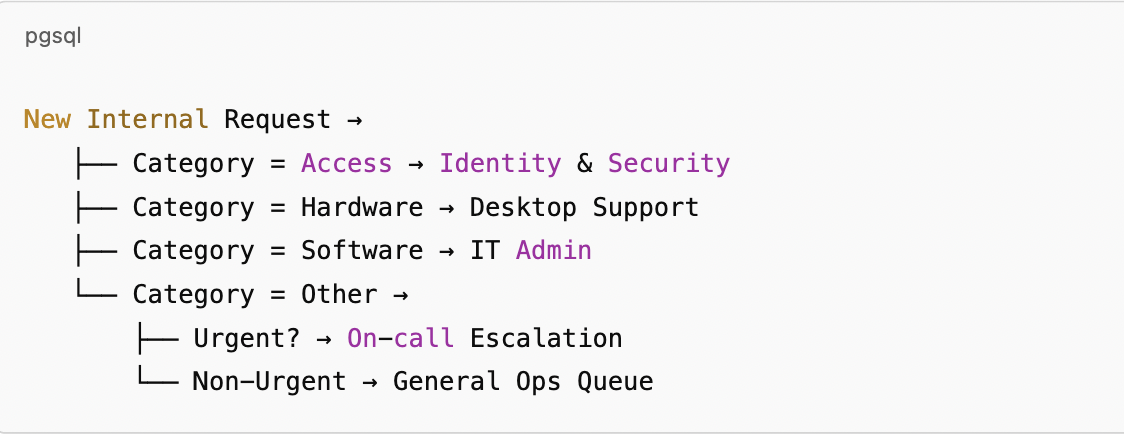
As the ops manager overseeing a fast-moving marketing project, you’re managing requests across social media, design, content, and a pool of freelancers. All this while racing toward tight client deadlines.
Everyone’s busy, but you’re stuck in the middle, wondering how to delegate. Your day involves chasing updates and untangling who’s supposed to do what. You must also manually assigning tasks as they come in.
With task routing, a design revision gets assigned to your available freelancer. Last-minute client edits go to your senior content lead for a quick turnaround.
Workflow Focus: Routing by task type + resource availability
Visual: Branching assignment logic

Your QA and engineering teams move fast—but when bug reports pile up from customers, testers, and internal teams, it becomes a mess. Task routing ensures those bugs don’t sit in a general backlog waiting to be picked.
Instead, each issue is routed based on component, severity, or source. UI bugs go to frontend, backend issues to the API team, and critical P1 blockers get flagged and escalated to a lead.
Your developers spend less time triaging and more time fixing the right bugs, which keeps sprints on track and releases moving.
Workflow focus: Routing by component + severity
Visual: Severity-based escalation path
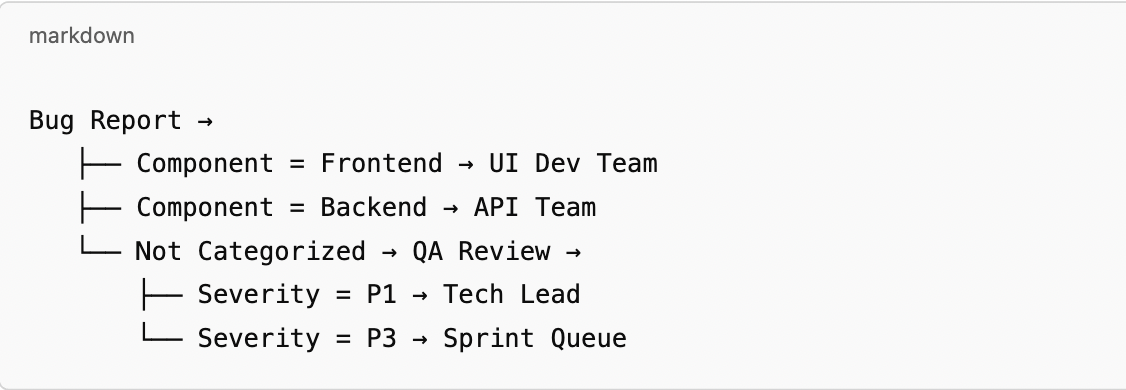
🔖 Bonus: How to Write a Bug Report
ClickUp, the everything app for work, gives you the power to automate task routing across teams.
ClickUp brings together automations, workload views, and custom logic so every task lands with the right person.
Here’s how it all comes together.
With ClickUp Tasks, you get a clear view of the tasks, who they’re assigned to, and their progress.
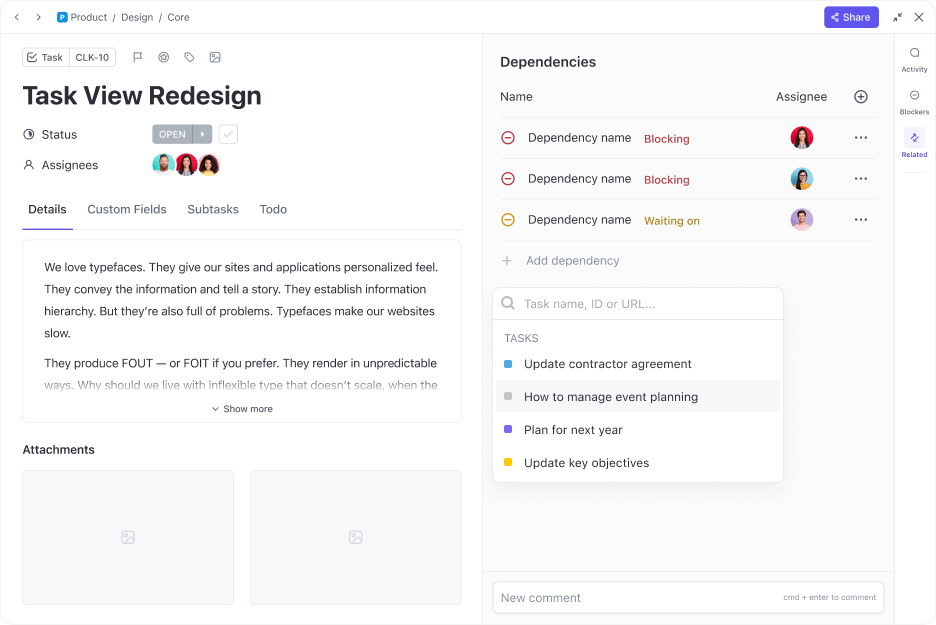
Here’s how you can use it:
When requests are long or unstructured, they will only slow down your teams. With ClickUp Brain, you can automatically analyze and summarize incoming tasks or tickets so they’re easier to route.
Here’s how you can use it:
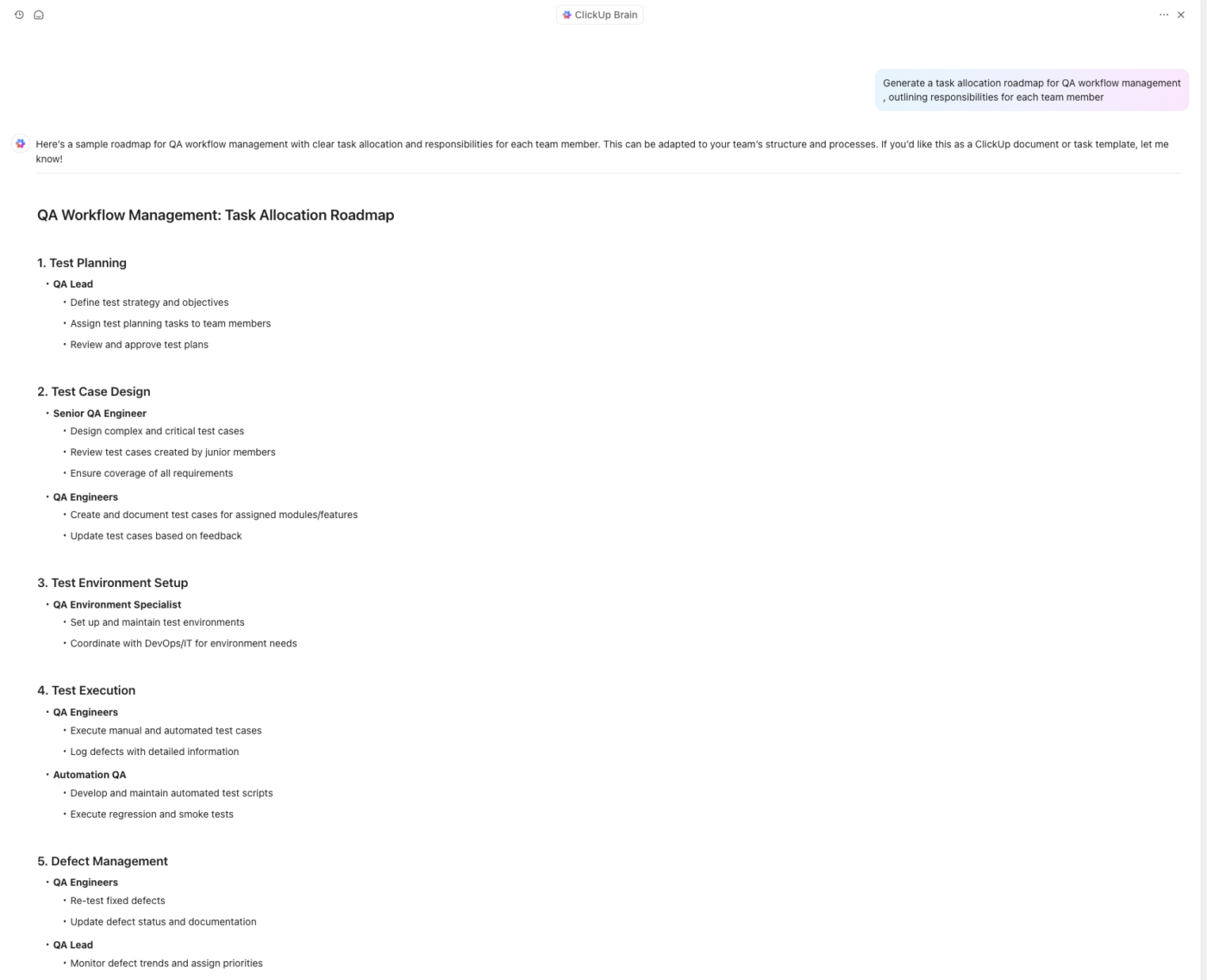
⚒️ Quick Hack: You can even auto-fill task properties using ClickUp Brain.
Going further, you can add prompts for each person by clicking Add prompt. You can use field variables like Task ID and Task Name in your prompts.
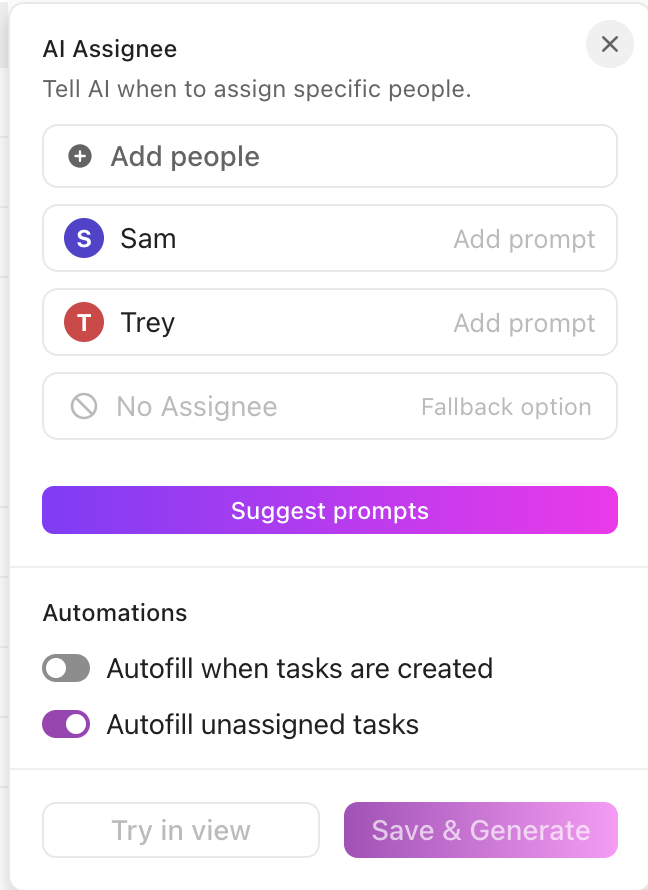
This is part of the broader benefit of using AI to automate tasks—letting your system do the heavy lifting before a human ever touches the work.
Instead of manually triaging tasks or chasing updates, you can set up smart automation rules that route work instantly based on what matters most to your routing workflows. It could be priority, tags, custom fields, or anything else.
With ClickUp Automations, you can:
⚒️ Quick Hack: Want more control over how tasks are routed? Use ClickUp’s Automation Conditions to layer multiple logic rules in a single automation.
For example, instead of routing every urgent task, you can fine-tune it:
“If task priority is High and the custom field Department is Product, then assign it to the Lead PM.”
This is the beauty of using a task automation software. Once you set up smart task routing workflows, everything runs on autopilot.

Once your automations are running, the next challenge is staying on top of what’s working (and what’s not). ClickUp Dashboards give you a real-time view of how tasks are flowing, who’s overloaded, and where bottlenecks may be forming.
Also, say, if you’re on the QA team. ClickUp Dashboards let you visualize bugs by type, track task statuses across stages, and monitor sprint velocity—all in one place.
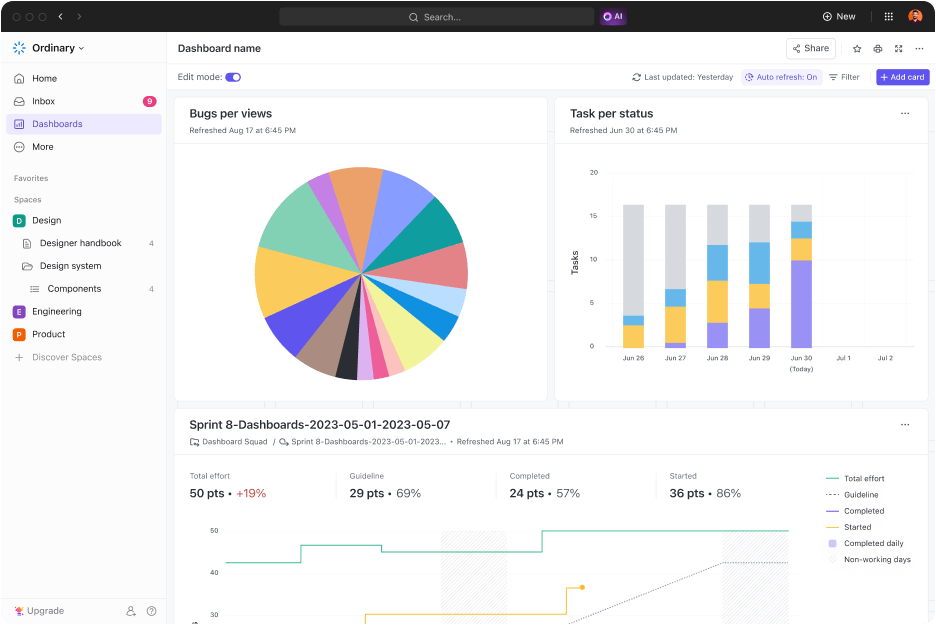
Use pie charts to identify where most bugs are surfacing, bar graphs to track how tasks are progressing through statuses, and sprint widgets to keep delivery on track.
ClickUp, a workflow app, offers robust features for scaling workflows across
Use Dependency Relationships to define the order of tasks, ensuring that certain tasks commence only after the completion of others. This is crucial for workflows where specific tasks are contingent on completing preceding ones.
Once a task is routed, it often doesn’t live in isolation. ClickUp Dependencies help link that task to the broader project workflow. For example, a support escalation can’t be routed to engineering until the QA step is complete.
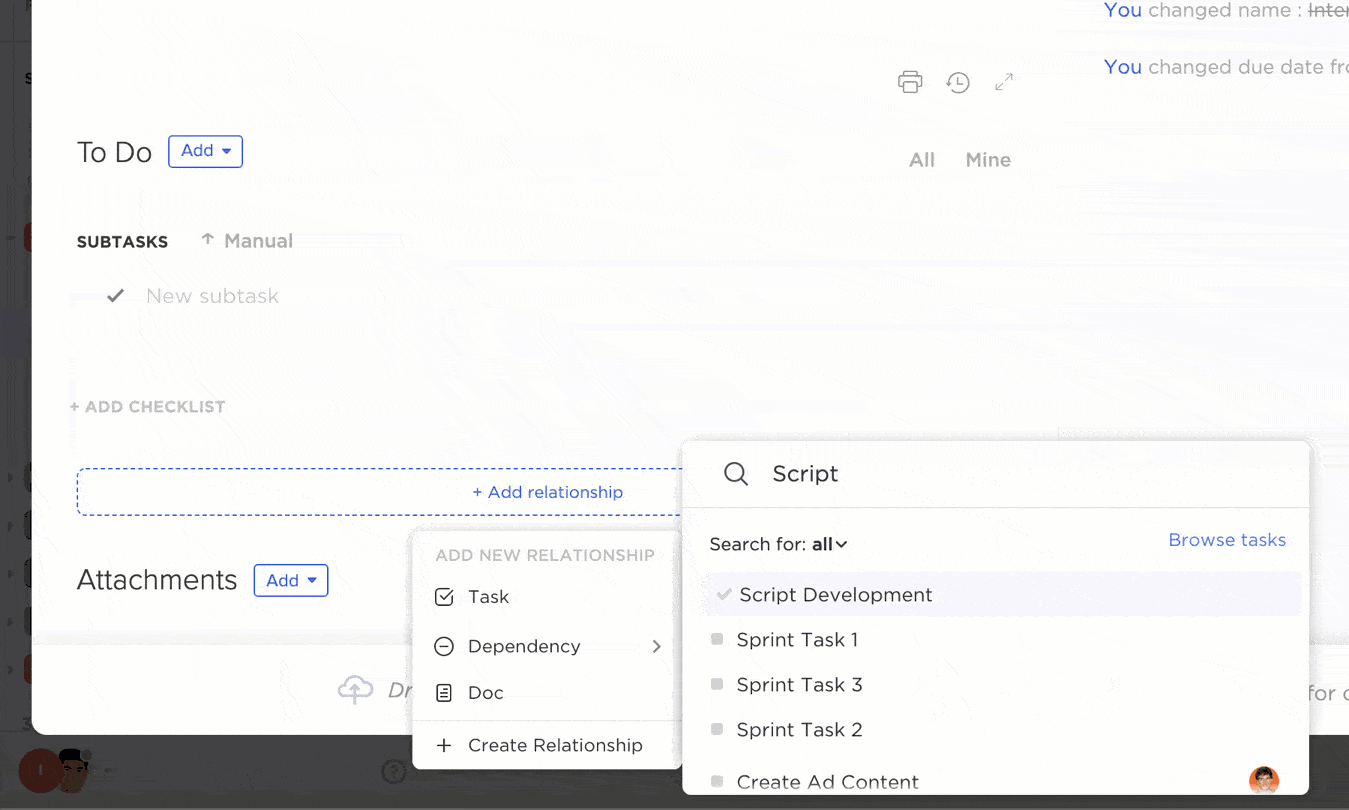
Then, ClickUp Task Templates let you pre-define everything—from routing logic to dependencies. This ensures your process is repeatable and error-free, an important step for building project management automation into your daily workflows.
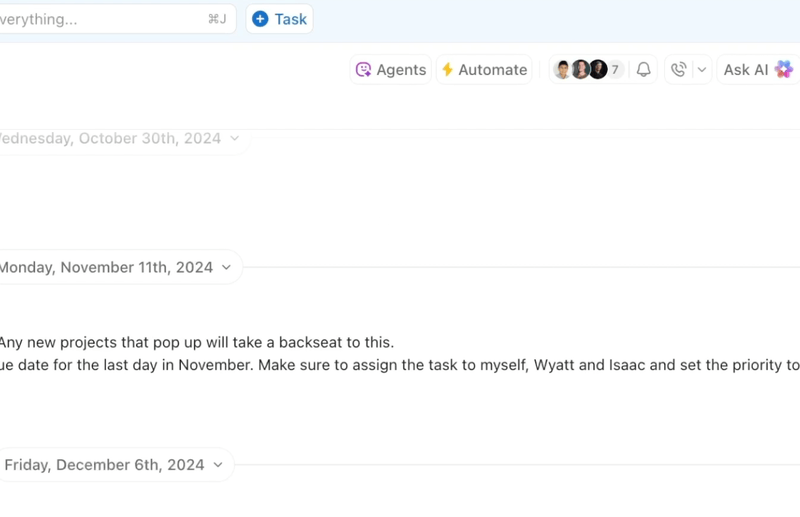
Finally ClickUp AI Agents can automate and optimize task routing, assignment, and follow-up actions, reducing manual work and ensuring tasks are distributed according to your rules or AI-driven logic.
You want to build the right workflows that scale. Not the ones that slow you down and are riddled with complexities. Here are the best practices that ensure your routing systems are adaptable and scalable.
The first step to effective routing is clarity. Before setting up any automations, start by defining what routing rules make sense for your team and processes.
This means identifying the key signals that determine who should receive a task:
💡 Pro Tip: In ClickUp, using Custom Fields, you can create fields such as “Task Type,” “Urgency,” or “Customer Tier” to categorize tasks accurately.
Although it’s tempting to build the perfect workflow from the get go, remember that the first few will need more work.
Here’s how to start building your task routing workflows:
💡 Pro Tip: Use simple “If X, then Y” automation rules with ClickUp Automations, then introduce conditional logic, nested triggers, or AI summarization by Brain once you have clean task metadata.
What works today may not work next quarter. Your routing logic should keep up as your team sizes, product complexity, or customer segments evolve.
Consider bookmarking your “Routing Review” dashboard and reviewing it monthly. It becomes your source of truth for tweaking automation logic and keeping workflows lean.
Here are some ClickUp Dashboard views to audit your routing logic.
Routing cannot live in silos. It should be part of your broader project delivery setup. This ensures that when tasks are routed, they move forward without friction:
A routed task is only useful if someone takes responsibility for it. Avoid ambiguity by making ownership explicit:
👀 Did You Know: Tasks without a clearly assigned owner are 2.5x more likely to fall through the cracks or be delayed by over 48 hours. According to a McKinsey study, unclear task ownership is a top cause of operational inefficiency, right behind lack of context and poor prioritization
Bottlenecks slow you down. Manual triage burns time. Smart task routing solves both by matching every task with the right person at the right moment.
With ClickUp Brain, you remove the guesswork through AI-powered classification and task summaries. Using Automations, you build routing systems that run on autopilot. And ClickUp Dashboards allow you to visualize workloads and rebalance before things break.
Whether you’re leading a high-volume support team or scaling internal ops, ClickUp helps you build scalable routing systems.
Sign up on ClickUp for free to start building your task routing workflows.
Traditional task assignment is manual and often based on availability. Task routing uses predefined rules or AI to assign tasks automatically, based on expertise, priority, or workload, for faster, more accurate delegation.
Task routing is one component of workflow automation. Routing ensures the right person gets the task, while workflow automation covers broader processes like updating fields, triggering follow-ups, and moving tasks through stages.
AI models can analyze task content, urgency, and historical performance to route work dynamically. This leads to smarter decisions like assigning VIP tickets to senior agents or escalating bugs based on sentiment.
In customer service, task routing automatically assigns tickets to the best-fit agent based on issue type, urgency, or customer tier. It helps reduce escalations, boost first-contact resolution, and balance workload.
Absolutely. Teams in sales, IT, operations, QA, and even agencies use task routing to streamline handoffs, reduce manual triage, and keep workflows moving across high-volume environments.
© 2025 ClickUp